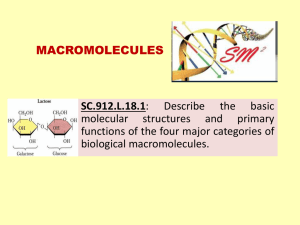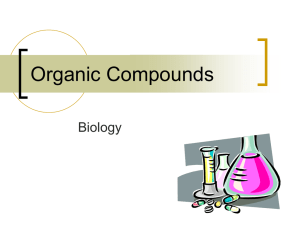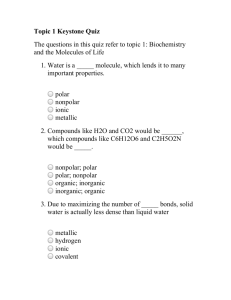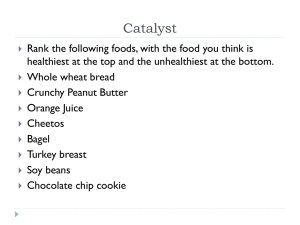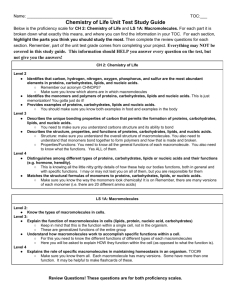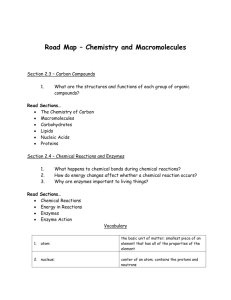Macromolecule Study Guideline Objectives
advertisement
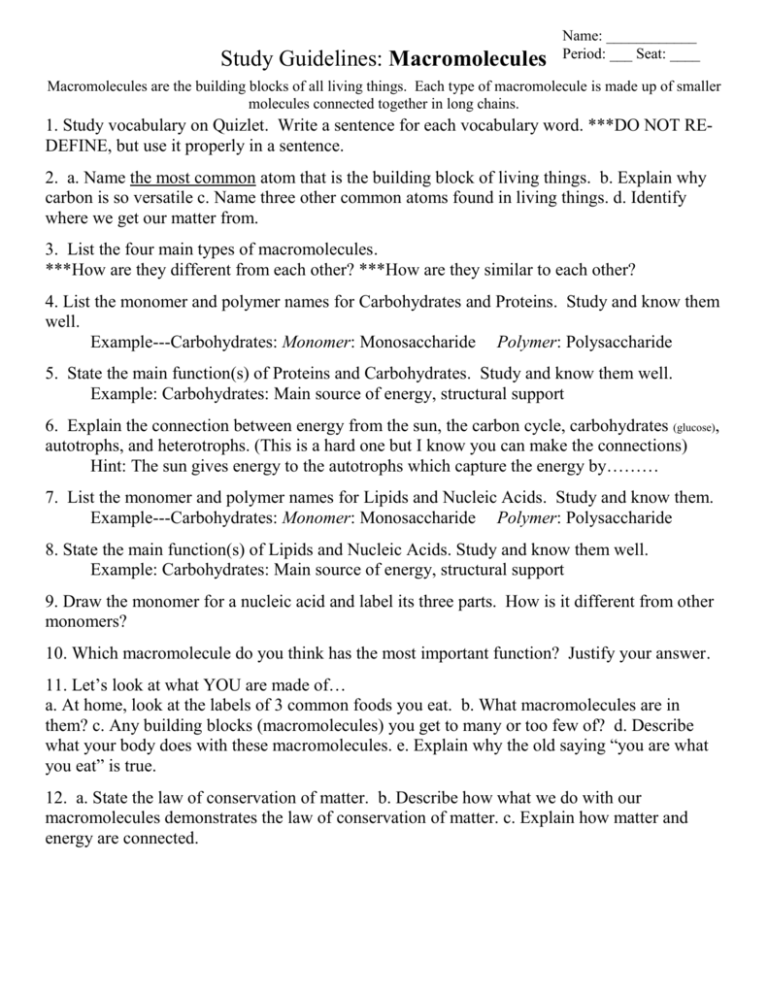
Study Guidelines: Macromolecules Name: ____________ Period: ___ Seat: ____ Macromolecules are the building blocks of all living things. Each type of macromolecule is made up of smaller molecules connected together in long chains. 1. Study vocabulary on Quizlet. Write a sentence for each vocabulary word. ***DO NOT REDEFINE, but use it properly in a sentence. 2. a. Name the most common atom that is the building block of living things. b. Explain why carbon is so versatile c. Name three other common atoms found in living things. d. Identify where we get our matter from. 3. List the four main types of macromolecules. ***How are they different from each other? ***How are they similar to each other? 4. List the monomer and polymer names for Carbohydrates and Proteins. Study and know them well. Example---Carbohydrates: Monomer: Monosaccharide Polymer: Polysaccharide 5. State the main function(s) of Proteins and Carbohydrates. Study and know them well. Example: Carbohydrates: Main source of energy, structural support 6. Explain the connection between energy from the sun, the carbon cycle, carbohydrates (glucose), autotrophs, and heterotrophs. (This is a hard one but I know you can make the connections) Hint: The sun gives energy to the autotrophs which capture the energy by……… 7. List the monomer and polymer names for Lipids and Nucleic Acids. Study and know them. Example---Carbohydrates: Monomer: Monosaccharide Polymer: Polysaccharide 8. State the main function(s) of Lipids and Nucleic Acids. Study and know them well. Example: Carbohydrates: Main source of energy, structural support 9. Draw the monomer for a nucleic acid and label its three parts. How is it different from other monomers? 10. Which macromolecule do you think has the most important function? Justify your answer. 11. Let’s look at what YOU are made of… a. At home, look at the labels of 3 common foods you eat. b. What macromolecules are in them? c. Any building blocks (macromolecules) you get to many or too few of? d. Describe what your body does with these macromolecules. e. Explain why the old saying “you are what you eat” is true. 12. a. State the law of conservation of matter. b. Describe how what we do with our macromolecules demonstrates the law of conservation of matter. c. Explain how matter and energy are connected. Study Guidelines: Macromolecules Name: ____________ Period: ___ Seat: ____ Macromolecules are the building blocks of all living things. Each type of macromolecule is made up of smaller molecules connected together in long chains. 1. Study vocabulary on Quizlet. Write a sentence for each vocabulary word. ***DO NOT REDEFINE, but use it properly in a sentence. 2. a. Name the most common atom that is the building block of living things. b. Explain why carbon is so versatile c. Name three other common atoms found in living things. d. Identify where we get our matter from. 3. List the four main types of macromolecules. ***How are they different from each other? ***How are they similar to each other? 4. List the monomer and polymer names for Carbohydrates and Proteins. Study and know them well. Example---Carbohydrates: Monomer: Monosaccharide Polymer: Polysaccharide 5. State the main function(s) of Proteins and Carbohydrates. Study and know them well. Example: Carbohydrates: Main source of energy, structural support 6. Explain the connection between energy from the sun, the carbon cycle, carbohydrates (glucose), autotrophs, and heterotrophs. (This is a hard one but I know you can make the connections) Hint: The sun gives energy to the autotrophs which capture the energy by……… 7. List the monomer and polymer names for Lipids and Nucleic Acids. Study and know them. Example---Carbohydrates: Monomer: Monosaccharide Polymer: Polysaccharide 8. State the main function(s) of Lipids and Nucleic Acids. Study and know them well. Example: Carbohydrates: Main source of energy, structural support 9. Draw the monomer for a nucleic acid and label its three parts. How is it different from other monomers? 10. Which macromolecule do you think has the most important function? Justify your answer. 11. Let’s look at what YOU are made of… a. At home, look at the labels of 3 common foods you eat. b. What macromolecules are in them? c. Any building blocks (macromolecules) you get to many or too few of? d. Describe what your body does with these macromolecules. e. Explain why the old saying “you are what you eat” is true. 12. a. State the law of conservation of matter. b. Describe how what we do with our macromolecules demonstrates the law of conservation of matter. c. Explain how matter and energy are connected.

